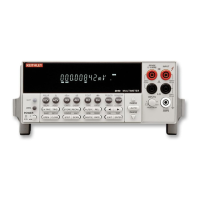Display board
Display board components are shown in the digital circuitry block diagram in Figure 4-2.
Microcontroller
U401 is the display board microcontroller that controls the display and interprets key data.
The microcontroller uses three internal peripheral I/O ports for the various control and read
functions. Display data is serially transmitted to the microcontroller from the digital section via
the TXB line to the microcontroller RDI terminal. In a similar manner, key data is serially sent
back to the digital section through the RXB line via TDO. The 4MHz clock for the
microcontroller is generated by crystal Y401.
Display
DS401 is the display module, which can display up to 12 alphanumeric characters and
includes the various annunciators.
The display uses a common multiplexing scheme with each character refreshed in sequence.
U402 and U403 are the drivers for the display characters and annunciators. Note that data for
the drivers is serially transmitted from the microcontroller (MOSI and PC1).
Filament voltage for the display is derived from the power supply transformer (F1 and F2).
The display drivers require +37VDC and +5VDC, which are supplied by U144 (+5VD) and
U101 (+37V).
Key matrix
The front panel keys (S401-S430) are organized into a row-column matrix to minimize the
number of microcontroller peripheral lines required to read the keyboard. A key is read by
strobing the columns and reading all rows for each strobed column. Key-down data is interpreted
by the display microcontroller and sent back to the main microprocessor using proprietary
encoding schemes.
Digital circuitry
Refer to Figure 4-2 for the following discussion on digital circuitry.
Microprocessor
U135 is a 68306 microprocessor that oversees all operating aspects of the instrument. The
MPU has a 16-bit data bus and provides an 18-bit address bus. It also has parallel and serial ports
for controlling various circuits. For example, the RXDA, TXDA, RXDB and TXDB lines are
used for the RS-232 interface.
The MPU clock frequency of 14.7456MHz is controlled by crystal Y101.
4-6 Troubleshooting

